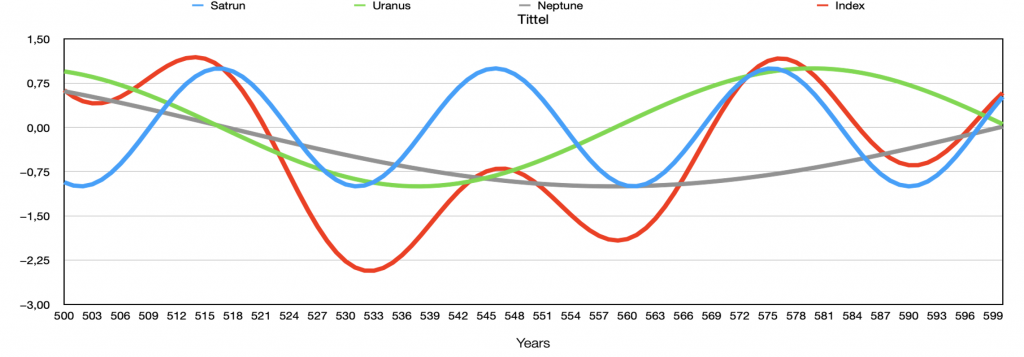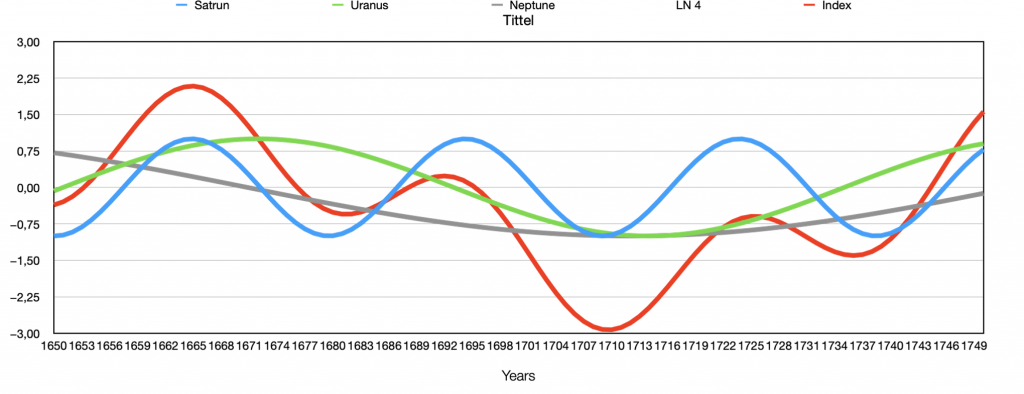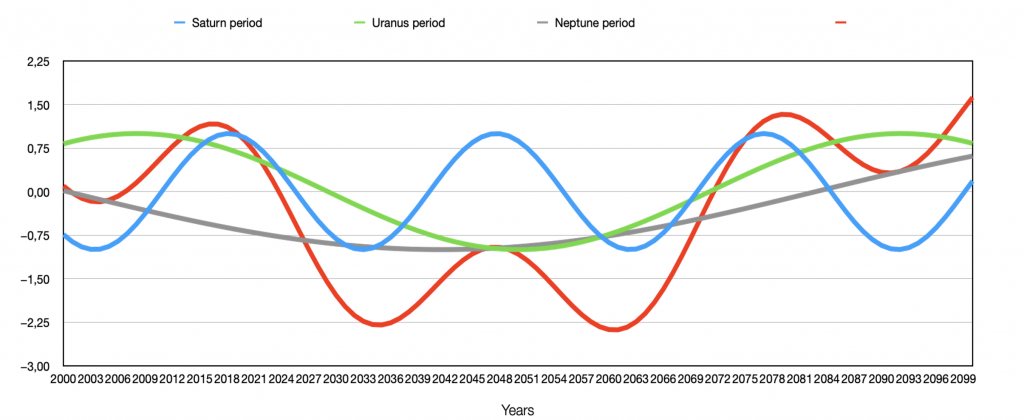Fimbulwinter is a referred to in the saga as an extremely cold climate period. A period of three years without summer. Norse mythology foretells of an upcoming Fimbulwinter. The Fenriswolf will devour the sun and all living things will freeze before Ragnarok. Investigations has revealed that the Fimbulwinter myth may come from the extremely cold years 535–536 AD. Real events indicate there may be a core of truth in the Fimbulwinter myth. The warning of an upcoming extremely cold period, which will have major consequences.
A deep solar minimum id coming.
Radiation from the sun has been considered constant since Aristotle. In the 1890s, astronomer E.W. Maunder reported that solar activity was greatly reduced in the years 1645 to 1715. There was a direct correlation between a minimum solar activity and the coldest climate period recorded in Europe. In the 1970s, scientists began to study ice core samples from Greenland. They revealed radiation from the sun has large variations over thousands of years. Periods of deep minima irradiation from the sun were named after solar scientists: Oort (1010-1070), Wolf (1270-1340), Spörer (1390-1550), Maunder (1640-1720) and Dalton (1790-1820). The periods of deep solar minima explained the Little Ice Age. Periodic distances between deep solar minima revealed that we can expect an upcoming cold climate period. This led to discussions about whether we can expect a Grand deep Maunder minimum, or a milder Dalton minimum.
Planet driven solar irradiation.
NASA started satellite-based measurement of solar radiation in 1979. In 2014, NASA researchers were able to publish a continuous data series for total solar radiation (TSI) for the years 1700-2013. An analysis of the TSI data series revealed the signature (periods) of the Jovian planets Jupiter (11 years), Saturn (29 years), Uranus (84 years) and Neptune (164 years) (JSUN). The same signature was identified in the sun’s rotation around the solar system’s barycenter. There is thus a direct connection between the elliptical orbits of the planets, the sun’s rotation around the center of gravity and total radiation from the sun [1].
The explanation is that the elliptical orbits of the planets change the speed of the sun’s rotation around the solar system’s barycenter. Changes in the sun’s rotation speed affect the sun’s internal dynamo and radiation from the sun’s surface. The sun has minimum radiation when the planets have a maximum speed in minimum distance to the sun. The radiation from the sun has a Deep minimum when UN planets have a minimum distance, a Grand minimum when the SUN planets are closest, and a Fimbulwinter minimum when the JSUN planets are closest to the sun at the same time. The sum of JSUN periods.
Fimbulwinter 525-536 AD.

Figure 1. The planetary periods for Saturn (blue), Uranus (green), Neptune (grey) and the TSI index (red) for the years AD 500-600.
Figure 1 shows how the SUN planets’ distances from the sun vary in the years 500-600 AD. TSI index (red) is the sum of the periods. It shows that radiation from the sun has a deep minimum in the years 520-570. The JSUN planets have a Fimbulwinter minimum (TSI index = -3.25) in the year 534 AD. Recent research shows that Northern Europe had an extremely low temperature in the years 535-536 AD.
A deep solar minimum in the years 520-570 leads to a global cooling up to the year 570 AD. Global temperature has a direct relationship to the sea’s surface temperature [2]. Inertia in cooling and warming of the sea’s surface leads to a calculated cold climate period in the years 530-665.
Swedish researchers have identified that Northern Europe had a deep cold climate period in the years 520-660. This cold climate period led to large migrations in Northern Europe. Half of the population in Norway and Sweden disappeared, and large areas became wastelands. Correspondence between JSUN periods repeats itself in periods of 500 years. Deep minimum and Fimbulwinter were repeated during the periods Oort (1020-1070), Spörer (1520-1570), and can be expected to return in the next deep minimum years 2025-2072.
1709. The perfect Fimbulwinter minimum.

Figure 2. Planetary periods for Saturn (blue), Uranus (green), Neptune (grey) and TSI index (red) for the years 1650-1750 AD.
The Maunder minimum period (1675-1745) is known as the coldest climate period in 4000 years. Figure 2 shows that the TSI index is negative in the years 1675-1745. The SUN periods have a Grand minimum the year 1709. At the same year, the JSUN periods have a perfect Fimbulwinter minimum, with an TSI index = -4.0. The year 1709 is referred to as “The Deep freeze”, the coldest year on record in Europe. In France, the temperature dropped to -20 degrees Celsius. Rivers, canal networks and harbors froze. The population in France fell by 600,000 from 1709 to 1710. The Baltic Sea was frozen over for four months and one could travel by horse and sledge across the sea from Denmark to Sweden. Arctic ice surrounded Iceland and moved south to Finnmark. In Norway and Sweden, large parts of the population disappeared.
Reduced solar activity from 1675 to 1745 leads to global cooling forward to the year 1745. Inertia in ocean cooling and warming leads to a calculated deep cold climate period in the years 1710-1760, with a Grand deep minimum in the year 1745. The year 1745 coincides with the maximum extent of the Jostedal glacier. The Greenland temperature in 1745, was the lowest in 4000 years [2].
Upcoming Fimbulwinter minimum
The Dalton period (1790-1820) is associated with the end of the Little Ice Age. The TSI index was negative in the period 1850-1900 and explains a cold climate period in the years 1885-1930. From 1900, the TSI index increases in a positive direction to a maximum the year 2017. This period explains the global warming 1930-2017. The TSI index maximum in 1917 turned as a positive index until the year 2025. The positive TSI index period can explain an almost constant global temperature 2017-2024.

Figure 3. Planetary periods for Saturn (blue), Uranus (green), Neptune (grey) and TSI index (red) for the years 2000-2100 AD.
The TSI index is negative in the period 2025-2072. In the cooling period forward to the year 2072, there is a computed Fimbulwinter minimum in the year 2064, where TSI index = -3.10. From 2072, the TSI index is positive, which leads to an expected new global warming. Inertia in cooling and warming of the ocean’s surface leads to an expected deep cold climate period in the years 2050-2100, with a Grand minimum temperature in the year 2072 [2].
Facts from climate data series, analyzed with new methods, tell us that the Little Ice Age did not end in the 19th century. Global warming in the 20th century was a climate variation that occurs in periods of approx. 170 years [2]. This warm climate period laid the foundations for ecological and industrial growth in the 20th century. After global warming, there will inevitably be a period of global cooling. A new deep cold climate period, going forward towards the year 2100, will have major consequences for global food production and global energy production. History tells us that we are particularly vulnerable to cold climate periods in Northern Europe.
Related CC-post
- The First Cause of Climate variability
- A Cold Climate Period is coming
- Solen varierer over 4450 år
- Ny kald klimaperiode
- «THE DEEEP FREEZE”
- Grand Solar Minima 1000-2100 A.D
References
- Yndestad, H., & Solheim, J. (2017). The influence of solar system oscillation on the variability of the total solar irradiance. New Astronomy, 51, 135–152. doi.org/10.1016/j.newast.2016.08.020.
https://ntnuopen.ntnu.no/ntnu-xmlui/handle/11250/2473902 - Yndestad H. 2022. Jovian Planets and Lunar Nodal Cycles in the Earth’s Climate Variability Frontiers in Astronomy and Space Sciences. May 10. 2022. https://doi.org/10.3389/fspas.2022.839794.

Would you be able to show the charts above including the Jupiter period? All the charts above have excluded that. Thx Shawn
Yes. If the figure cover only 20-30 years